Discovery of Cisplatin Binding to Thymine and Cytosine on a Single-Stranded Oligodeoxynucleotide by High Resolution FT-ICR Mass Spectrometry
Abstract
:1. Introduction
2. Results and Discussion
2.1. Interactions of Cisplatin and ODN15
2.2. Identification of Binding Sites of Cisplatin on ODN15 by Top-Down MS
2.3. Binding Models of Cisplatin to Pyrimidines
3. Materials and Methods
3.1. Materials
3.2. Sample Preparation
3.3. FT-ICR Mass Spectrometry Analysis
3.4. Molecular Modeling
4. Conclusions
Supplementary Materials
Author Contributions
Funding
Conflicts of Interest
References
- Jung, Y.; Lippard, S.J. Direct Cellular Responses to Platinum-Induced DNA Damage. Chem. Rev. 2007, 107, 1387–1407. [Google Scholar] [CrossRef] [PubMed]
- Sherman, S.E.; Lippard, S.J. Structural aspects of platinum anticancer drug interactions with DNA. Chem. Rev. 1987, 87, 1153–1181. [Google Scholar] [CrossRef]
- Kelland, L. The resurgence of platinum-based cancer chemotherapy. Nat. Rev. Cancer 2007, 7, 573. [Google Scholar] [CrossRef]
- Bellon, S.F.; Coleman, J.H.; Lippard, S.J. DNA unwinding produced by site-specific intrastrand crosslinks of the antitumor drug cis-diamminedichloroplatinum(II). Biochemistry 1991, 30, 8026–8035. [Google Scholar] [CrossRef]
- Todd, R.C.; Lippard, S.J. Structure of duplex DNA containing the cisplatin 1,2-{Pt(NH3)2}2+-d(GpG) cross-link at 1.77Å resolution. J. Inorg. Biochem. 2010, 104, 902–908. [Google Scholar] [CrossRef]
- Jamieson, E.R.; Lippard, S.J. Structure, Recognition, and Processing of Cisplatin−DNA Adducts. Chem. Rev. 1999, 99, 2467–2498. [Google Scholar] [CrossRef] [PubMed]
- Eastman, A. Interstrand crosslinks and sequence specificity in the reaction of cis-dichloro(ethylenediamine)platinum(II) with DNA. Biochemistry 1985, 24, 5027–5032. [Google Scholar] [CrossRef] [PubMed]
- Eastman, A. Reevaluation of interaction of cis-dichloro(ethylenediamine)platinum(II) with DNA. Biochemistry 1986, 25, 3912–3915. [Google Scholar] [CrossRef]
- Fichtinger-Schepman, A.M.J.; van Oosterom, A.T.; Lohman, P.H.M.; Berends, F. cis-Diamminedichloroplatinum(II)-induced DNA Adducts in Peripheral Leukocytes from Seven Cancer Patients: Quantitative Immunochemical Detection of the Adduct Induction and Removal after a Single Dose of cis-Diamminedichloroplatinum(II). Cancer Res. 1987, 47, 3000–3004. [Google Scholar] [PubMed]
- Gupta, R.; Beck, J.L.; Sheil, M.M.; Ralph, S.F. Identification of bifunctional GA and AG intrastrand crosslinks formed between cisplatin and DNA. J. Inorg. Biochem. 2005, 99, 552–559. [Google Scholar] [CrossRef]
- Mansy, S.; Chu, G.Y.H.; Duncan, R.E.; Tobias, R.S. Heavy metal nucleotide interactions. 12. Competitive reactions in systems of four nucleotides with cis- or trans-diammineplatinum(II). Raman difference spectrophotometry of the relative nucleophilicity of guanosine, cytidine, adenosine, and uridine monophosphates and analogous DNA bases. J. Am. Chem. Soc. 1978, 100, 607–616. [Google Scholar]
- Davidson, J.P.; Faber, P.J.; Fischer, R.G.; Mansy, S.; Peresie, H.J.; Rosenberg, B.; VanCamp, L. "Platinum-pyrimidine blues" and related complexes: A new class of potent antitumor agents. Cancer Chemother. Rep. 1975, 59, 287–300. [Google Scholar] [PubMed]
- Barton, J.K.; Rabinowitz, H.N.; Szalda, D.J.; Lippard, S.J. Synthesis and crystal structure of cis-diammineplatinum alpha.-pyridone blue. J. Am. Chem. Soc. 1977, 99, 2827–2829. [Google Scholar] [CrossRef]
- Chu, G.Y.H.; Duncan, R.E.; Tobias, R.S. Heavy metal-nucleoside interactions. 10. Binding of cis-diammineplatinum(II) to cytidine and uridine in aqueous solution: Necessary conditions for formation of platinum-uridine "blues". Inorg. Chem. 1977, 16, 2625–2636. [Google Scholar] [CrossRef]
- Flynn, C.M.; Viswanathan, T.S.; Martin, R.B. The constitution of platinum blues. J. Inorg. Nucl. Chem. 1977, 39, 437–439. [Google Scholar] [CrossRef]
- Lippert, B.; Pfab, R.; Neugebauer, D. The role of N(1) coordianted thynine in ‘platinum thymine blue’. Inorg. Chim. Acta 1979, 37, L495–L497. [Google Scholar] [CrossRef]
- Lippert, B.; Neugebauer, D. Simultaneous binding of two different transition metals to the DNA model base 1-methylthymine: The x-ray structure of Bis[bis(μ-1-methylthyminato-N3, O4)cis-diammine platinum(II)] silver nitrate pentahydrate. Inorg. Chim. Acta 1980, 46, 171–179. [Google Scholar] [CrossRef]
- Lippert, B. Rare iminol tautomer of 1-methylthymine through metal coordination at N(3). Inorg. Chim. Acta 1981, 55, 5–14. [Google Scholar] [CrossRef]
- Neugebauer, D.; Lippert, B. A second modification of the head-tail dimer bis(μ-1-methylthyminato)-bis(cis-diammineplatinum(II) dinitrate and its differentiation from the corresponding head-head dimer. Inorg. Chim. Acta 1982, 67, 151–158. [Google Scholar] [CrossRef]
- Sherman, S.E.; Gibson, D.; Wang, A.H.; Lippard, S.J. X-ray structure of the major adduct of the anticancer drug cisplatin with DNA: Cis-[Pt(NH3)2(d(pGpG))]. Science 1985, 230, 412. [Google Scholar] [CrossRef]
- Van Garderen, C.J.; Van Houte, L.P.A. The Solution Structure of a DNA Duplex Containing the cis -Pt(NH3)2[d(-GTG-)-N 7(G), N 7(G)] Adduct, as Determined with High-Field NMR and Molecular Mechanics/Dynamics. Eur. J. Biochem. 1994, 225, 1169–1179. [Google Scholar] [CrossRef] [Green Version]
- Koomen, J.M.; Ruotolo, B.T.; Gillig, K.J.; McLean, J.A.; Russell, D.H.; Kang, M.; Dunbar, K.R.; Fuhrer, K.; Gonin, M.; Schultz, A.J. Oligonucleotide analysis with MALDI–ion-mobility–TOFMS. Anal. Bioanal.Chem. 2002, 373, 612–617. [Google Scholar] [CrossRef] [PubMed]
- Dorcier, A.; Hartinger, C.G.; Scopelliti, R.; Fish, R.H.; Keppler, B.K.; Dyson, P.J. Studies on the reactivity of organometallic Ru–, Rh– and Os–pta complexes with DNA model compounds. J. Inorg. Biochem. 2008, 102, 1066–1076. [Google Scholar] [CrossRef]
- Sherman, S.E.; Gibson, D.; Wang, A.H.J.; Lippard, S.J. Crystal and molecular structure of cis-[Pt(NH3)2[d(pGpG)]], the principal adduct formed by cis-diamminedichloroplatinum(II) with DNA. J. Am. Chem. Soc. 1988, 110, 7368–7381. [Google Scholar] [CrossRef]
- Huang, H.; Zhu, L.; Reid, B.R.; Drobny, G.P.; Hopkins, P.B. Solution Structure of a Cisplatin-Induced DNA Interstrand Cross-Link. Science 1995, 270, 1842. [Google Scholar] [CrossRef] [PubMed]
- Takahara, P.M.; Rosenzweig, A.C.; Frederick, C.A.; Lippard, S.J. Crystal structure of double-stranded DNA containing the major adduct of the anticancer drug cisplatin. Nature 1995, 377, 649. [Google Scholar] [CrossRef] [PubMed]
- Takahara, P.M.; Frederick, C.A.; Lippard, S.J. Crystal Structure of the Anticancer Drug Cisplatin Bound to Duplex DNA. J. Am. Chem. Soc. 1996, 118, 12309–12321. [Google Scholar] [CrossRef] [Green Version]
- Beck, J.L.; Colgrave, M.L.; Ralph, S.F.; Sheil, M.M. Electrospray ionization mass spectrometry of oligonucleotide complexes with drugs, metals, and proteins. Mass Spectrom. Rev. 2001, 20, 61–87. [Google Scholar] [CrossRef]
- Wang, F.; Bella, J.; Parkinson, J.A.; Sadler, P.J. Competitive reactions of a ruthenium arene anticancer complex with histidine, cytochrome c and an oligonucleotide. J. Biol. Inorg. Chem. 2005, 10, 147–155. [Google Scholar] [CrossRef]
- Wu, K.; Luo, Q.; Hu, W.; Li, X.; Wang, F.; Xiong, S.; Sadler, P.J. Mechanism of interstrand migration of organoruthenium anticancer complexes within a DNA duplex. Metallomics 2012, 4, 139–148. [Google Scholar] [CrossRef]
- Wu, K.; Hu, W.; Luo, Q.; Li, X.; Xiong, S.; Sadler, P.J.; Wang, F. Competitive Binding Sites of a Ruthenium Arene Anticancer Complex on Oligonucleotides Studied by Mass Spectrometry: Ladder-Sequencing versus Top-Down. J. Am. Soc. Mass. Spectrom. 2013, 24, 410–420. [Google Scholar] [CrossRef] [PubMed]
- Liu, S.; Wu, K.; Zheng, W.; Zhao, Y.; Luo, Q.; Xiong, S.; Wang, F. Identification and discrimination of binding sites of an organoruthenium anticancer complex to single-stranded oligonucleotides by mass spectrometry. Analyst 2014, 139, 4491–4496. [Google Scholar] [CrossRef] [PubMed]
- Egger, A.E.; Hartinger, C.G.; Hamidane, H.B.; Tsybin, Y.O.; Keppler, B.K.; Dyson, P.J. High Resolution Mass Spectrometry for Studying the Interactions of Cisplatin with Oligonucleotides. Inorg. Chem. 2008, 47, 10626–10633. [Google Scholar] [CrossRef]
- Wootton, C.A.; Sanchez-Cano, C.; Liu, H.-K.; Barrow, M.P.; Sadler, P.J.; O’Connor, P.B. Binding of an organo–osmium(ii) anticancer complex to guanine and cytosine on DNA revealed by electron-based dissociations in high resolution Top–Down FT-ICR mass spectrometry. Dalton Trans. 2015, 44, 3624–3632. [Google Scholar] [CrossRef]
- Li, L.; Guo, W.; Wu, K.; Wu, X.; Zhao, L.; Zhao, Y.; Luo, Q.; Wang, Y.; Liu, Y.; Zhang, Q.; et al. A comparative study on the interactions of human copper chaperone Cox17 with anticancer organoruthenium(II) complexes and cisplatin by mass spectrometry. J. Inorg. Biochem. 2016, 161, 99–106. [Google Scholar] [CrossRef] [PubMed]
- Hu, W.; Luo, Q.; Wu, K.; Li, X.; Wang, F.; Chen, Y.; Ma, X.; Wang, J.; Liu, J.; Xiong, S.; et al. The anticancer drug cisplatin can cross-link the interdomain zinc site on human albumin. Chem. Commun. 2011, 47, 6006–6008. [Google Scholar] [CrossRef]
- Reedijk, J. Why Does Cisplatin Reach Guanine-N7 with Competing S-Donor Ligands Available in the Cell? Chem. Rev. 1999, 99, 2499–2510. [Google Scholar] [CrossRef]
- McLuckey, S.A.; Van Berker, G.J.; Glish, G.L. Tandem mass spectrometry of small, multiply charged oligonucleotides. J. Am. Soc. Mass. Spectrom. 1992, 3, 60–70. [Google Scholar] [CrossRef]
- McLuckey, S.A.; Habibi-Goudarzi, S. Decompositions of multiply charged oligonucleotide anions. J. Am. Chem. Soc. 1993, 115, 12085–12095. [Google Scholar] [CrossRef]
- Wu, J.; McLuckey, S.A. Gas-phase fragmentation of oligonucleotide ions. Int. J. Mass Spectrom. 2004, 237, 197–241. [Google Scholar] [CrossRef]
- Vrkic, A.K.; O’Hair, R.A.J.; Foote, S.; Reid, G.E. Fragmentation reactions of all 64 protonated trimer oligodeoxynucleotides and 16 mixed base tetramer oligodeoxynucleotides via tandem mass spectrometry in an ion trap11Dedicated to Professor Jim Morrison on the occasion of his 75th birthday and in recognition of his important contributions to mass spectrometry.22This article is Part XVIII of the series “Gas Phase Ion Chemistry of Biomolecules.”. Int. J. Mass Spectrom. 2000, 194, 145–164. [Google Scholar]
- Klimasauskas, S.; Kumar, S.; Roberts, R.J.; Cheng, X. Hhal methyltransferase flips its target base out of the DNA helix. Cell 1994, 76, 357–369. [Google Scholar] [CrossRef]
- Priyakumar, U.D.; MacKerell, A.D. Computational Approaches for Investigating Base Flipping in Oligonucleotides. Chem. Rev. 2006, 106, 489–505. [Google Scholar] [CrossRef]
- Krueger, A.; Protozanova, E.; Frank-Kamenetskii, M.D. Sequence-Dependent Basepair Opening in DNA Double Helix. Biophys. J. 2006, 90, 3091–3099. [Google Scholar] [CrossRef] [Green Version]
- Eastman, A. Separation and characterization of products resulting from the reaction of cis-diamminedichloroplatinum(II) with deoxyribonucleosides. Biochemistry 1982, 21, 6732–6736. [Google Scholar] [CrossRef]
- Mansy, S.; Rosenberg, B.; Thomson, A.J. Binding of cis- and trans-dichlorodiammineplatinum(II) to nucleosides.i. Location of the binding sites. J. Am. Chem. Soc. 1973, 95, 1633–1640. [Google Scholar] [CrossRef] [PubMed]
- Roos, I.A.G.; Thomson, A.J.; Eagles, J. Mass spectrometric studies of the interaction of platinum complexes with nucleoside analogues. Chem. Biol. Interact. 1974, 8, 421–427. [Google Scholar] [CrossRef]
- Munchausen, L.L.; Rahn, R.O. Physical studies on the binding of cis-dichlorodiamine platinum(II) to DNA and homopolynucleotides. Biochim. Biophys. Acta 1975, 414, 242–255. [Google Scholar] [CrossRef]
- Inagaki, K.; Kidani, Y. Binding sites between platinum(II) and uracil derivatives. J. Inorg. Biochem. 1978, 9, 157–166. [Google Scholar] [CrossRef]
- Marzilli, L.G.; Kistenmacher, T.J. Stereoselectivity in the binding of transition-metal chelate complexes to nucleic acid constituents: Bonding and nonbonding effects. Acc. Chem. Res. 1977, 10, 146–152. [Google Scholar] [CrossRef]
- Vinje, J.; Sletten, E.; Kozelka, J. Influence of dT20 and [d(AT)10]2 on Cisplatin Hydrolysis Studied by Two-Dimensional [1H,15N] HMQC NMR Spectroscopy. Chem.-Eur. J. 2005, 11, 3863–3871. [Google Scholar] [CrossRef] [PubMed]
- Van der Wijst, T.; Fonseca Guerra, C.; Swart, M.; Bickelhaupt, F.M.; Lippert, B. Rare Tautomers of 1-Methyluracil and 1-Methylthymine: Tuning Relative Stabilities through Coordination to PtII Complexes. Chem.-Eur. J. 2009, 15, 209–218. [Google Scholar] [CrossRef]
- Thewalt, U.; Neugebauer, D.; Lippert, B. Tridentate 1-methyluracil in a tetranuclear Pt2,Ag2 complex. Crystal structure and solution behavior of bis(.mu.-1-methyluracilato)bis(cis-diammineplatinum(II))disilver tetranitrate-2-water (head-tail), cis-[(NH3)2Pt(C5H5N2O2)Ag]2(NO3)4.cntdot.2H2O. Inorg. Chem. 1984, 23, 1713–1718. [Google Scholar] [CrossRef]
- Shu, X.; Xiong, X.; Song, J.; He, C.; Yi, C. Base-Resolution Analysis of Cisplatin–DNA Adducts at the Genome Scale. Angew. Chem. Int. Ed. 2016, 55, 14246–14249. [Google Scholar] [CrossRef] [Green Version]
Sample Availability: Not available. |
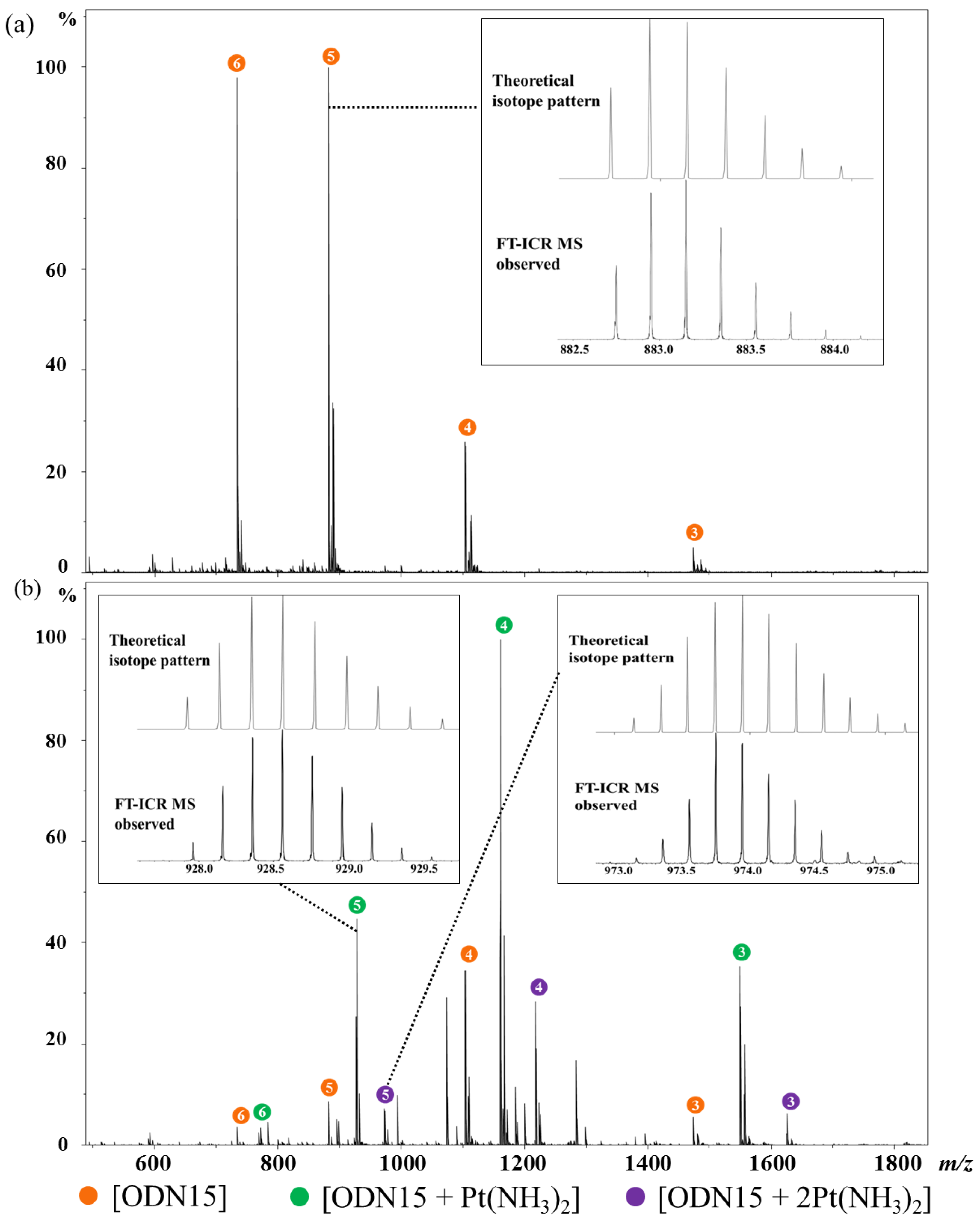
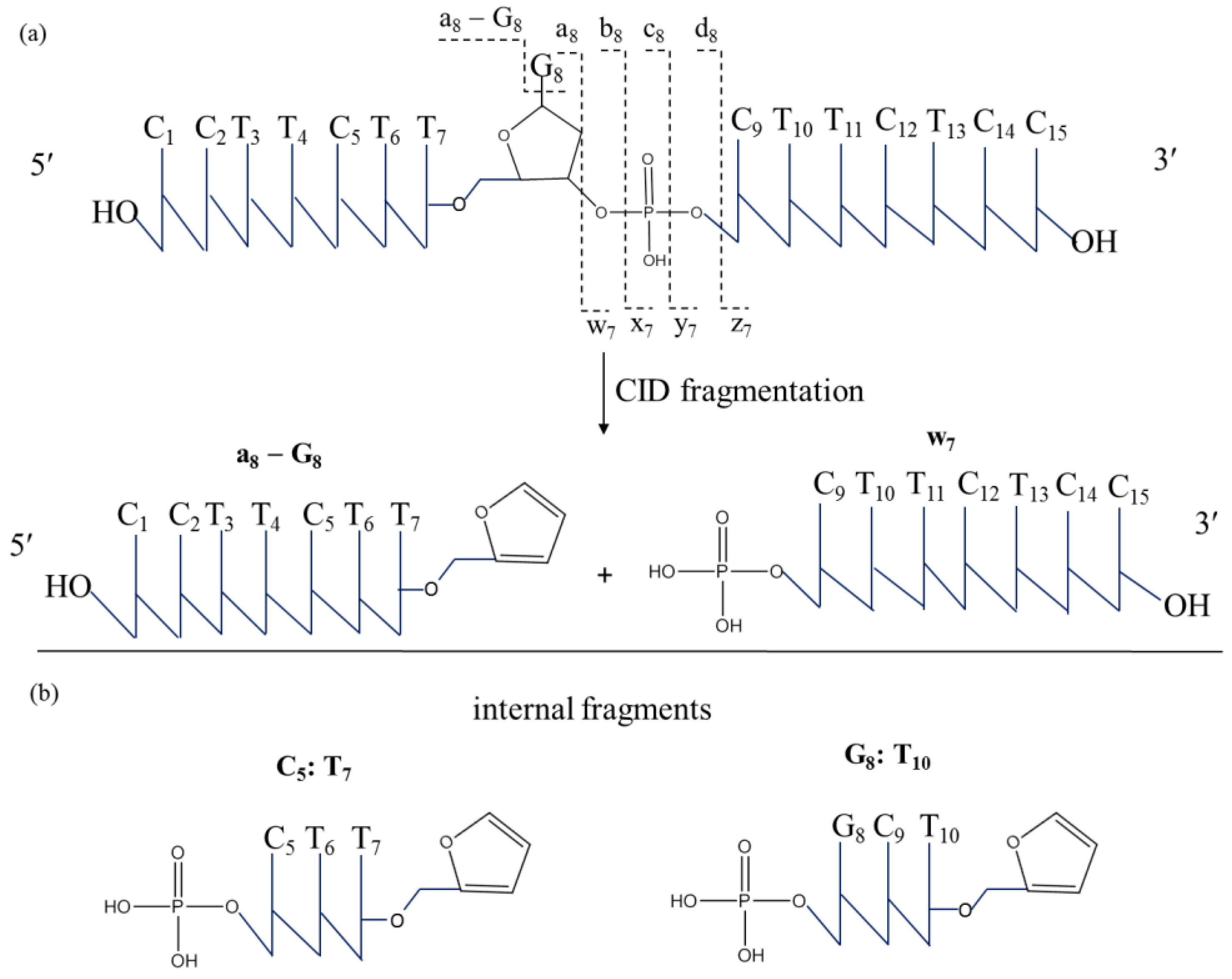
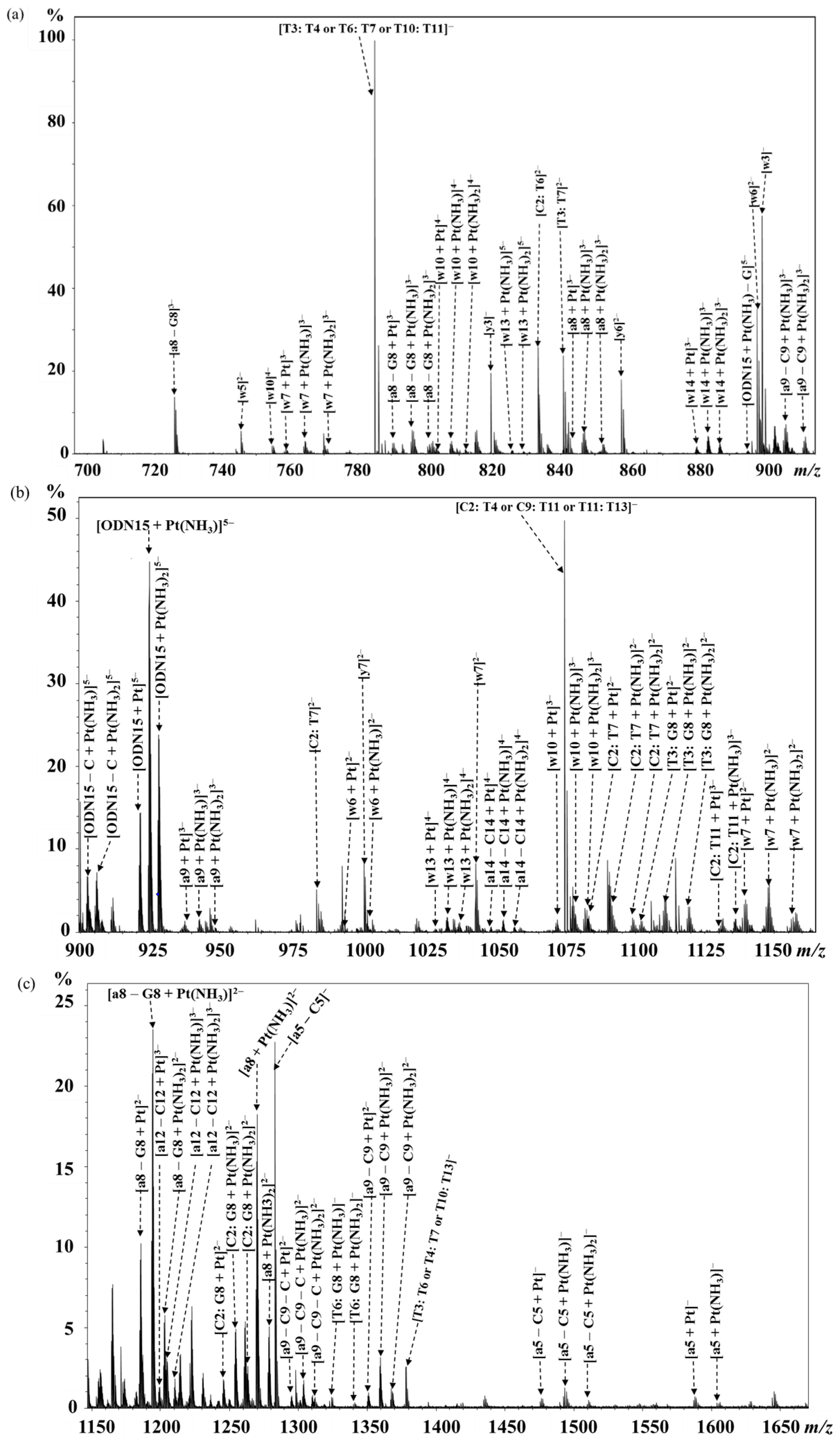
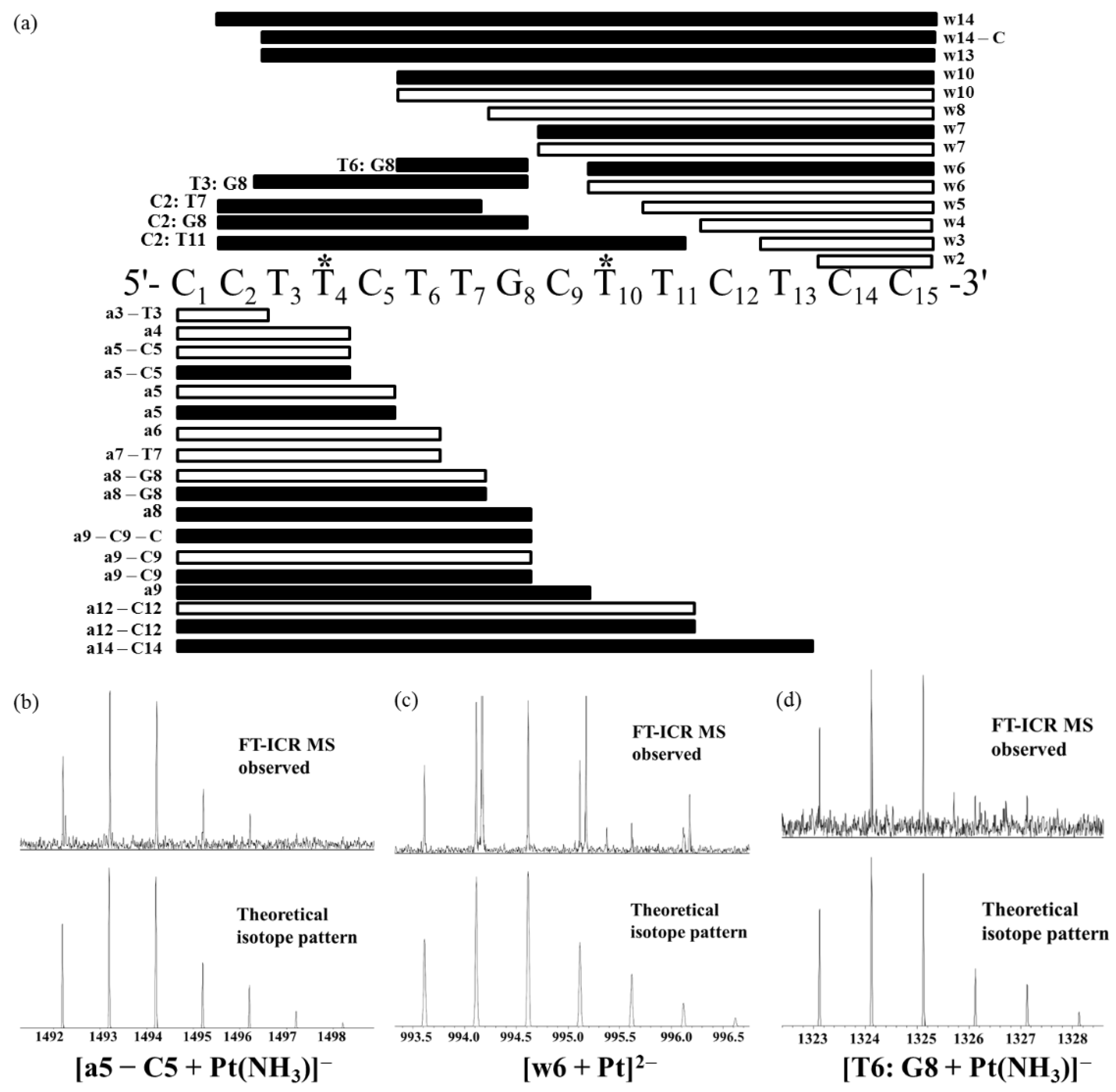
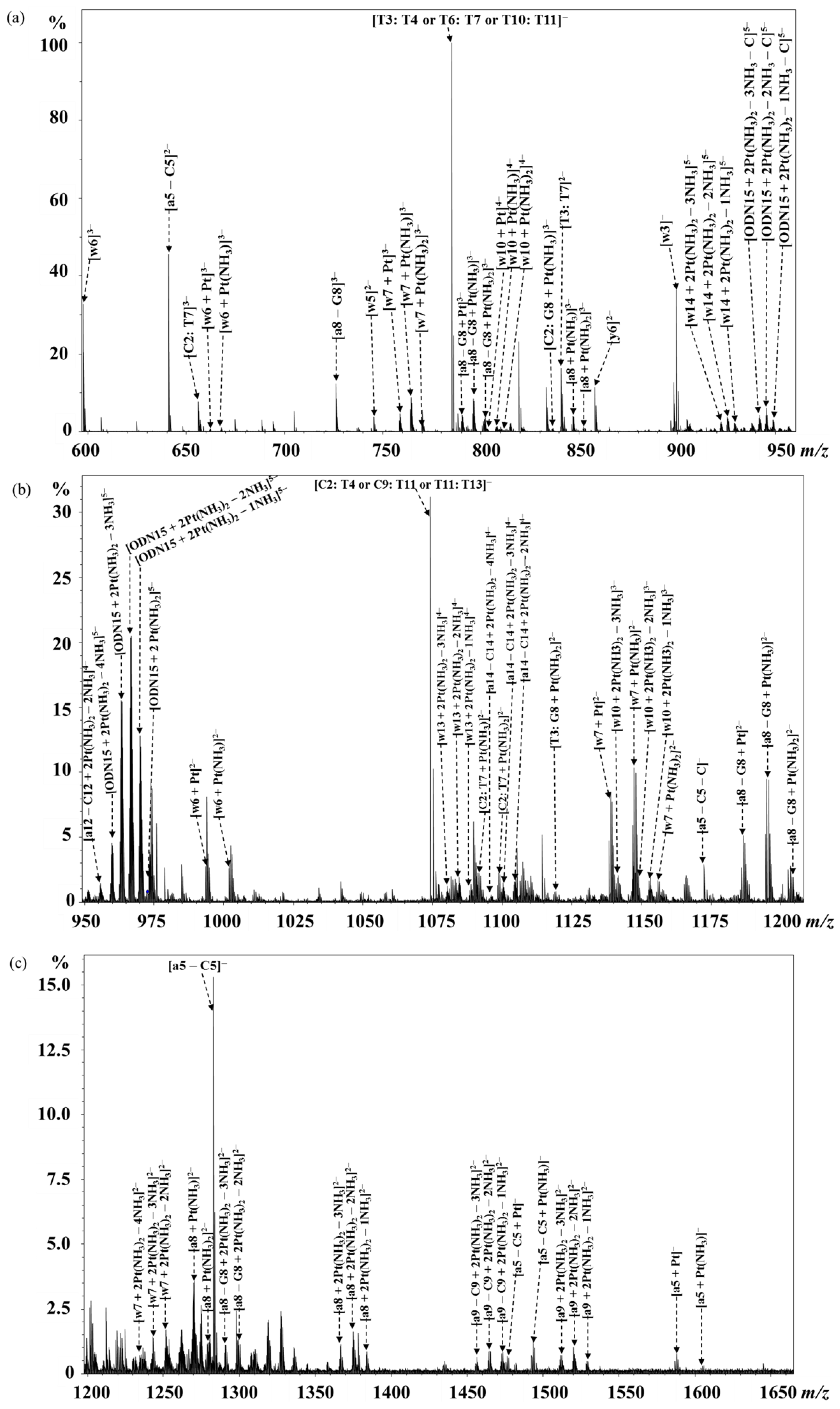
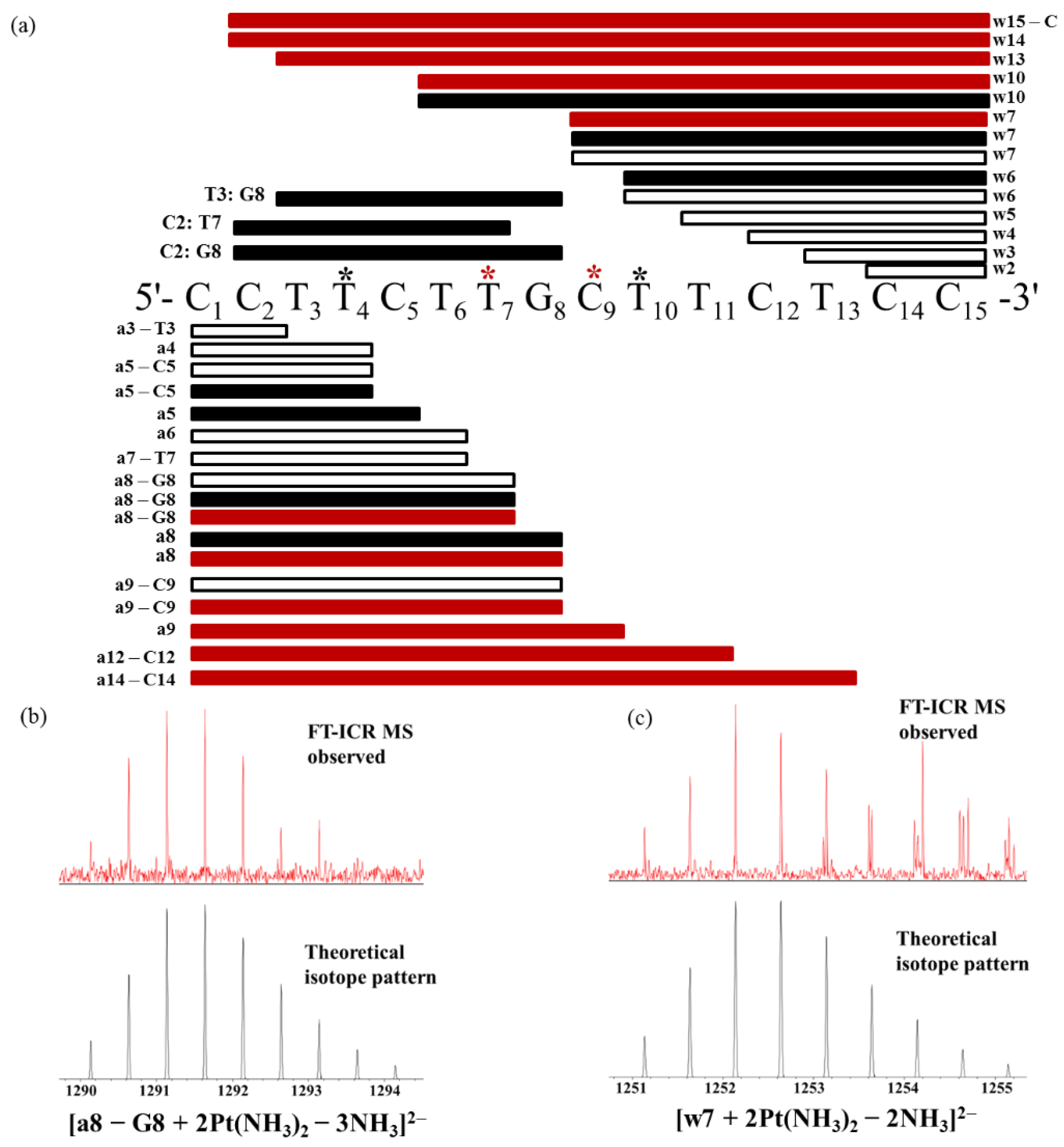
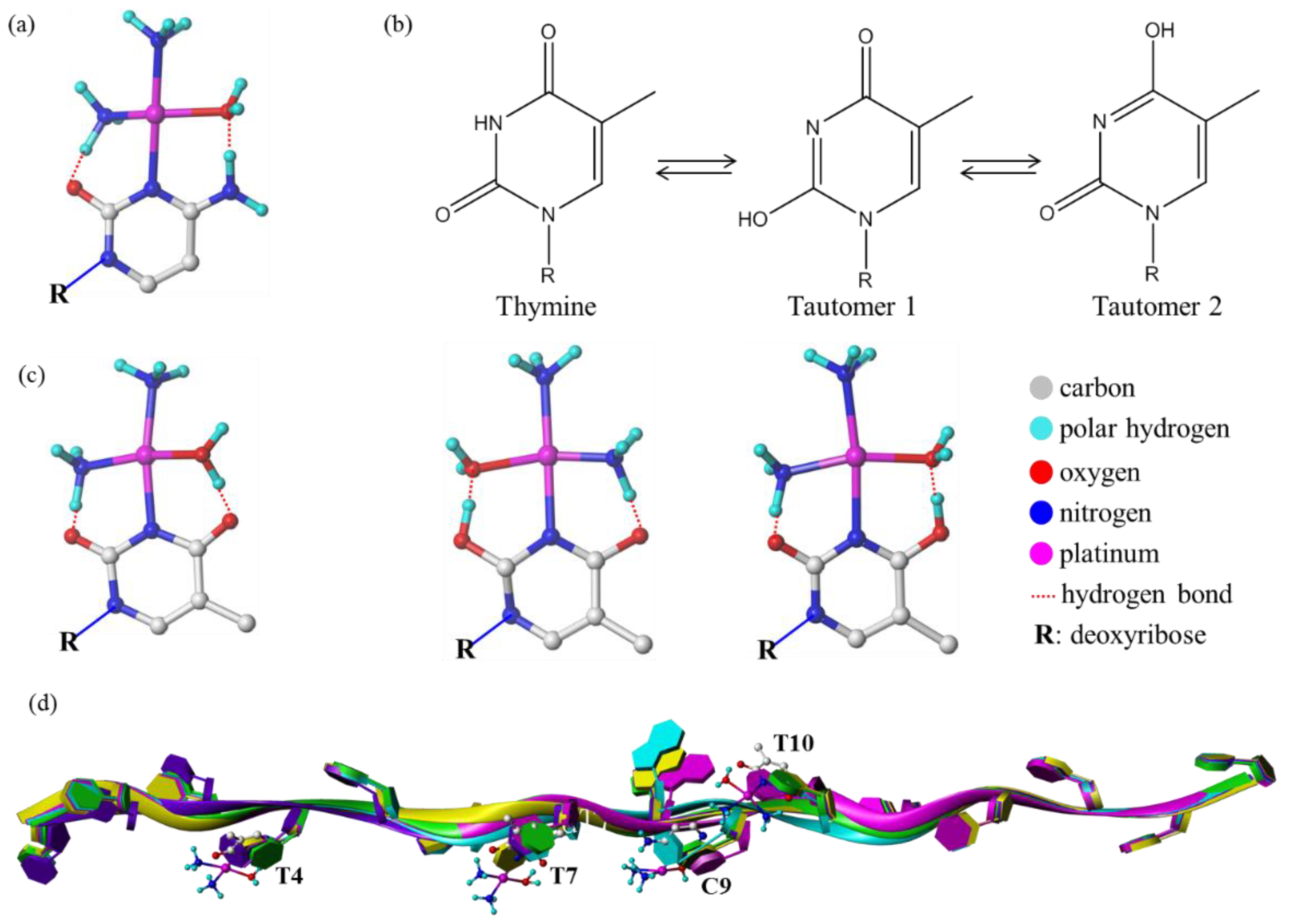
© 2019 by the authors. Licensee MDPI, Basel, Switzerland. This article is an open access article distributed under the terms and conditions of the Creative Commons Attribution (CC BY) license (http://creativecommons.org/licenses/by/4.0/).
Share and Cite
Zeng, W.; Zhang, Y.; Zheng, W.; Luo, Q.; Han, J.; Liu, J.; Zhao, Y.; Jia, F.; Wu, K.; Wang, F. Discovery of Cisplatin Binding to Thymine and Cytosine on a Single-Stranded Oligodeoxynucleotide by High Resolution FT-ICR Mass Spectrometry. Molecules 2019, 24, 1852. https://doi.org/10.3390/molecules24101852
Zeng W, Zhang Y, Zheng W, Luo Q, Han J, Liu J, Zhao Y, Jia F, Wu K, Wang F. Discovery of Cisplatin Binding to Thymine and Cytosine on a Single-Stranded Oligodeoxynucleotide by High Resolution FT-ICR Mass Spectrometry. Molecules. 2019; 24(10):1852. https://doi.org/10.3390/molecules24101852
Chicago/Turabian StyleZeng, Wenjuan, Yanyan Zhang, Wei Zheng, Qun Luo, Juanjuan Han, Jian’an Liu, Yao Zhao, Feifei Jia, Kui Wu, and Fuyi Wang. 2019. "Discovery of Cisplatin Binding to Thymine and Cytosine on a Single-Stranded Oligodeoxynucleotide by High Resolution FT-ICR Mass Spectrometry" Molecules 24, no. 10: 1852. https://doi.org/10.3390/molecules24101852
APA StyleZeng, W., Zhang, Y., Zheng, W., Luo, Q., Han, J., Liu, J., Zhao, Y., Jia, F., Wu, K., & Wang, F. (2019). Discovery of Cisplatin Binding to Thymine and Cytosine on a Single-Stranded Oligodeoxynucleotide by High Resolution FT-ICR Mass Spectrometry. Molecules, 24(10), 1852. https://doi.org/10.3390/molecules24101852





